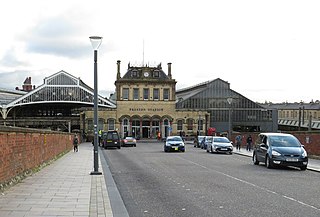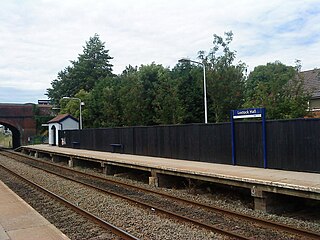
The Lancaster and Carlisle Railway was a main line railway opened between those cities in 1846. With its Scottish counterpart, the Caledonian Railway, the Company launched the first continuous railway connection between the English railway network and the emerging network in central Scotland. The selection of its route was controversial, and strong arguments were put forward in favour of alternatives, in some cases avoiding the steep gradients, or connecting more population centres. Generating financial support for such a long railway was a challenge, and induced the engineer Joseph Locke to make a last-minute change to the route: in the interests of economy and speed of construction, he eliminated a summit tunnel at the expense of steeper gradients.
The Birmingham and Gloucester Railway (B&GR) was the first name of the railway linking the cities in its name and of the company which pioneered and developed it; the line opened in stages in 1840, using a terminus at Camp Hill in Birmingham. It linked with the Bristol and Gloucester Railway in Gloucester, but at first that company's line was broad gauge, and Gloucester was a point of the necessary but inconvenient transhipment of goods and passengers onto 4 ft 8+1⁄2 in gauge that became the national standard. Nearly all of the original main line remains active as a "trunk" route, also known as an arterial route or line.
The Preston and Wyre Railway was promoted to open up agricultural land in the Fylde in Lancashire, access a new port at what became Fleetwood and the Lancaster Canal at Preston: it opened in 1840. An associated company built the dock leading to the company changing its name to the Preston and Wyre Railway, Harbour and Dock Company. Passenger business was more buoyant than expected, and the company built branch lines to the nascent resort of Blackpool and Lytham that opened in 1846. At that time the line was leased by the Lancashire and Yorkshire Railway and later the London and North Western Railway took a share in the lease which was later converted to outright ownership. The Preston and Wyre Railway continued to be jointly owned as the Preston and Wyre Joint Railway.
The East Lancashire Railway operated from 1844 to 1859 in the historic county of Lancashire, England. It began as a railway from Clifton via Bury to Rawtenstall, and during its short life grew into a complex network of lines connecting towns and cities including Liverpool, Manchester, Salford, Preston, Burnley and Blackburn.
The Bolton and Leigh Railway (B&LR) was the first public railway in Lancashire. It opened for goods on 1 August 1828, and thus preceded the Liverpool and Manchester Railway (L&MR) by two years. Passengers were carried from 1831. The railway operated independently until 1845 when it became part of the Grand Junction Railway.
The North Union Railway was an early British railway company, operating two main routes, from Parkside to Preston and from Bolton Trinity Street to Preston, all in Lancashire. The northerly part of the routes sharing the line from Euxton to Preston.
The Lancaster and Preston Junction Railway opened its twenty-mile line in 1840 in Lancashire, England. The company was not commercially successful. When the Lancaster and Carlisle Railway opened in 1846, the L&PJR became part of a busy trunk railway. It had never had the money to provide substantial track equipment or proper signalling arrangements. Most of the line is in use today as part of the West Coast Main Line railway and has been electrified. None of the L&PJR stations is still in use.

Preston railway station in Preston, Lancashire, England, is an interchange railway station on the West Coast Main Line, half-way between London Euston and Glasgow Central. It is served by Avanti West Coast, Northern Trains and TransPennine Express services, plus Caledonian Sleeper overnight services between London and Scotland. It is also served by the Calder Valley line to Leeds and York, and by branch lines to Blackpool, Ormskirk, and Colne.

Bamber Bridge railway station serves the village of Bamber Bridge in Lancashire, England. It is situated on the East Lancashire Line and is managed by Northern.

Lostock Hall railway station is a railway station serving the village of Lostock Hall in the South Ribble borough of Lancashire, England. It is on the East Lancashire Line and is managed by Northern, who also provide all passenger trains serving it.
The West Lancashire Railway (WLR) ran northeast from Southport to Preston in northwest England.

Farington railway station served Farington, south of Preston in Lancashire, England.

Maudlands railway station (also known as Maudland railway station, or Preston Maudland(s)) was the original Preston terminus of the Preston and Wyre Joint Railway to Fleetwood, in Lancashire, England. It was located on Leighton Street. The line and the station opened on 15 July 1840. The line crossed the Lancaster and Preston Junction Railway (L&PJR) on the level, immediately to the west of the station.

Hest Bank railway station was opened by the Lancaster and Carlisle Railway (L&CR) three miles north of Lancaster Castle railway station. The line had been authorised in 1844 and a station was proposed for the village of Hest Bank, Lancashire, the following year. It opened in 1846 along with the line. The station continued to serve the village of Hest Bank until its closure in 1969. The site remains notable as being the point at which the present-day West Coast Main Line (WCML) comes nearest to the west coast. Views of Morecambe Bay can be glimpsed from trains on this section of the line.

The first Lancaster railway station was the northern terminus of the Lancaster and Preston Junction Railway, located in the Greaves area of the city of Lancaster, Lancashire, England. It was open from 1840 to 1849, by which time it had been superseded by Lancaster Castle railway station. Some books refer to the station as "Lancaster (Greaves)" or "Lancaster " to distinguish it from later stations in the city, although whilst open it was known simply as "Lancaster" as there was no other station of that name at the same time.
The Bolton and Preston Railway (B&PR) connected Bolton and Preston, in Lancashire, England. Its authorising Act of Parliament forbade its early completion to protect the North Union Railway (NUR) and imposed other restrictions that limited the success of the B&PR. A change of route was authorised to bypass the delay making it dependent on the goodwill of the NUR to reach Preston. The NUR saw the B&PR as a competitor and used underhand tactics to harm the success of the B&PR.
Parkside railway station was an original station on the Liverpool and Manchester Railway. It then became the interchange station between lines when the Wigan Branch Railway opened in 1832, moving to the physical junction of the two lines in 1838. The station continued as an interchange until being by-passed in 1847 when a west curve was opened to facilitate north–south links that did not go through the station. Traffic declined further after the Winwick cut-off opened in 1864 leading to closure in 1878.

Lowton railway station served the village named Town of Lowton to the east of Newton-le-Willows and south of Golborne.
Euxton was an early railway station serving Euxton in Chorley, Lancashire, England.











